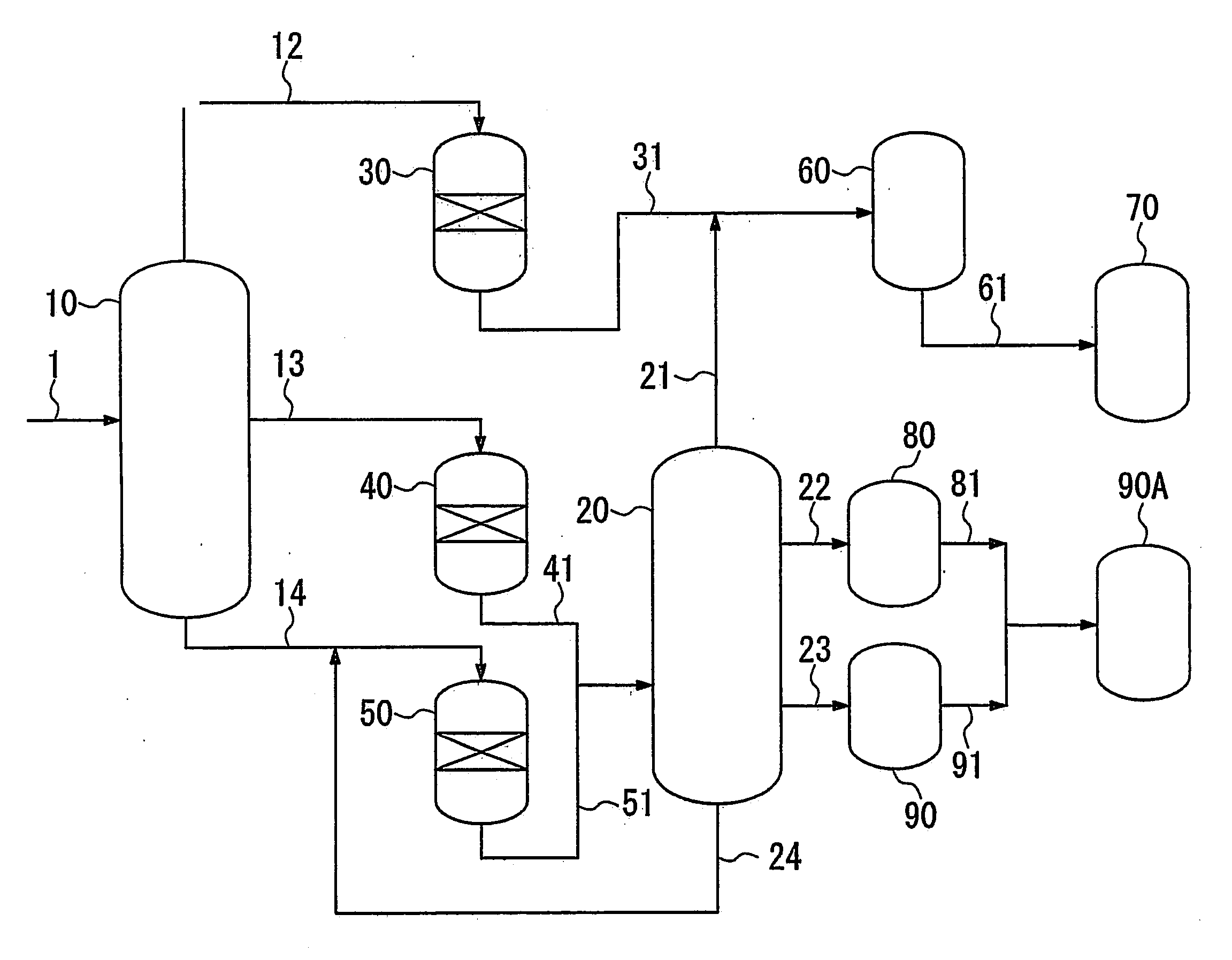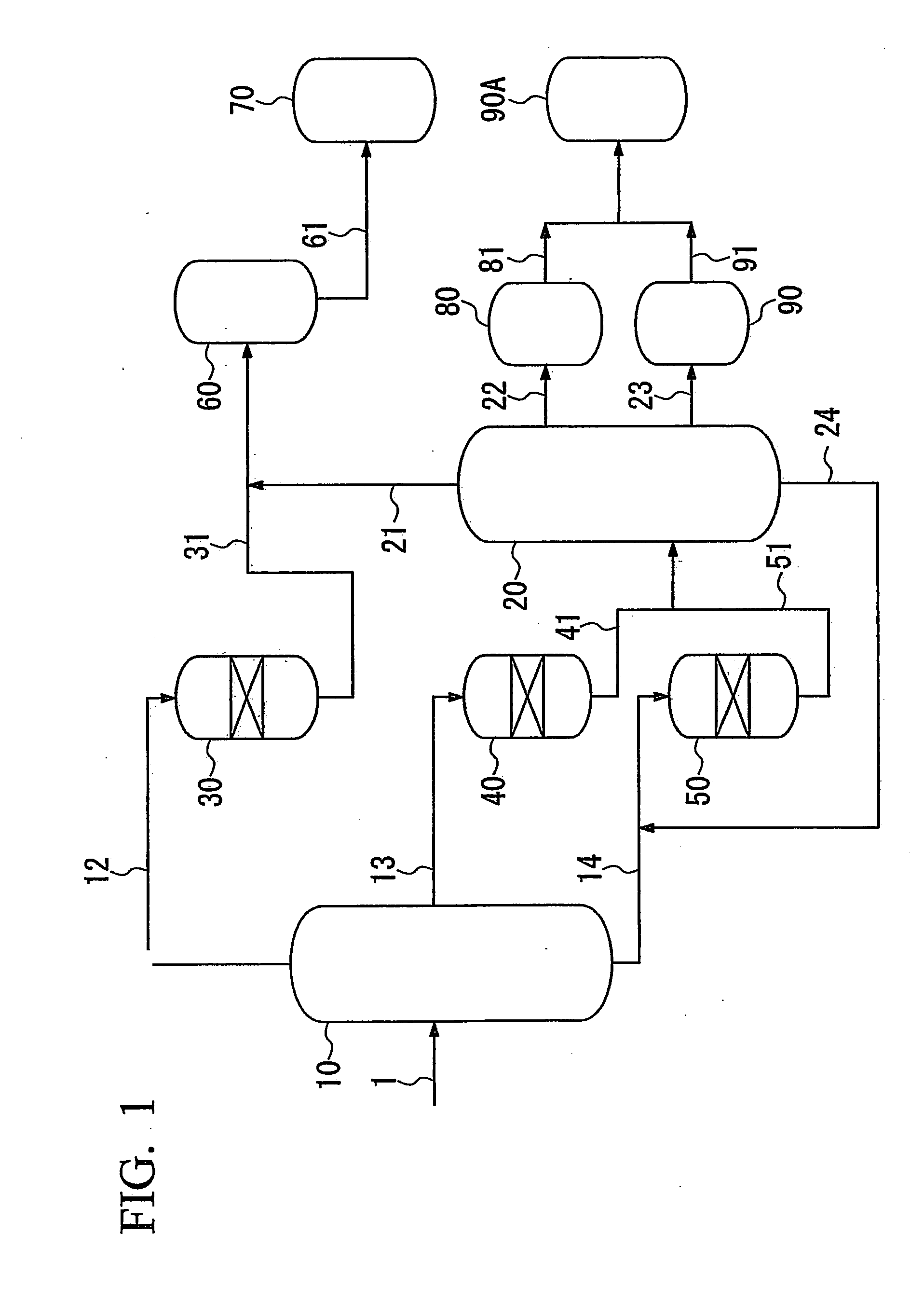Method of manufacturing diesel fuel
a technology of diesel fuel and manufacturing method, which is applied in the direction of fuels, naphtha treatment, hydrocarbon oil treatment products, etc., can solve the problems of insufficient low temperature performance of the ft middle fraction, and achieve the effects of reducing the boiling range, increasing the production in manufacturing, and being easy to predi
- Summary
- Abstract
- Description
- Claims
- Application Information
AI Technical Summary
Benefits of technology
Problems solved by technology
Method used
Image
Examples
example 1
Manufacture of Diesel Fuel
(Fractionation of FT Synthetic Oil)
[0111]In the first fractionator, oil produced by a FT synthesis method (i.e. FT synthetic oil) (the content of hydrocarbons having a boiling point of 150° C. or higher was 84% by mass, and the content of hydrocarbons having a boiling point of 360° C. or higher was 42% by mass, based on the total amount of the FT synthetic oil (corresponding to the sum of hydrocarbons having 5 or more carbon atoms)) was fractionated into a naphtha fraction having a boiling point of less than 150° C., a first middle fraction having a boiling point of 150° C. to 350° C. and a wax fraction as a bottom fraction.
(Hydroisomerization of First Middle Fraction)
[0112]The hydroisomerizing reactor 40, which is a fixed-bed flow reactor, was filled with the catalyst A (150 ml), the above-obtained middle fraction was supplied thereto from the tower apex of the hydroisomerizing reactor 40 at a rate of 225 ml / h, and the middle fraction was hydrogen-treated ...
example 2
[0123]In this example, the fractionation of FT synthetic oil, the hydroisomerization of the first middle fraction, the hydrocracking of the wax fraction, and the fractionation of hydroisomerized products and hydrocracked products were performed in the same manner as in Example 1.
(Prediction of Kinematic Viscosity and Pour Point)
[0124]Assuming that 40% by mass of the kerosene fraction 1 was blended with 60% by mass of the gas oil fraction 1 to produce a diesel fuel, an average molecular weight (x[M.W.]) of the diesel fuel and the content (nC19+) of n-paraffins having 19 or more carbon atoms in the diesel fuel were predicted based on the all component analysis. The predicted values are shown in Table 3. The kinematic viscosity at 30° C. and the PP of the diesel fuel are calculated by applying x[M.W.] and [nC19+] to the above-mentioned Equations 1 and 2 and the calculated values are also shown in Table 3.
[0125]The kinematic viscosity at 30° C. (calculated value) and PP (calculated valu...
example 3
Fractionation of FT Synthetic Oil
[0126]In the first fractionator, oil produced by a FT synthesis method (i.e. FT synthetic oil) (the content of hydrocarbons having a boiling point of 150° C. or higher was 84% by mass, and the content of hydrocarbons having a boiling point of 360° C. or higher was 42% by mass, based on the total amount of the FT synthetic oil (corresponding to the sum of hydrocarbons having 5 or more carbon atoms)) was fractionated into a naphtha fraction having a boiling point of less than 150° C., a first middle fraction having a boiling point of 150° C. to 350° C. and a wax fraction as a bottom fraction.
(Hydroisomerization of First Middle Fraction)
[0127]The fixed-bed flow reactor was filled with the catalyst A (150 ml), the above-obtained middle fraction was supplied thereto from the tower apex of the hydroisomerizing reactor 40 at a rate of 225 ml / h, and the middle fraction was hydrogen-treated in a hydrogen stream under reaction conditions shown in Table 1.
[0128...
PUM
| Property | Measurement | Unit |
|---|---|---|
| pour point | aaaaa | aaaaa |
| kinematic viscosity | aaaaa | aaaaa |
| pour point | aaaaa | aaaaa |
Abstract
Description
Claims
Application Information
 Login to View More
Login to View More - R&D
- Intellectual Property
- Life Sciences
- Materials
- Tech Scout
- Unparalleled Data Quality
- Higher Quality Content
- 60% Fewer Hallucinations
Browse by: Latest US Patents, China's latest patents, Technical Efficacy Thesaurus, Application Domain, Technology Topic, Popular Technical Reports.
© 2025 PatSnap. All rights reserved.Legal|Privacy policy|Modern Slavery Act Transparency Statement|Sitemap|About US| Contact US: help@patsnap.com


